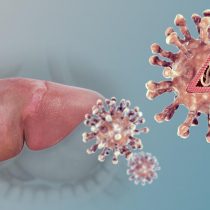
Every July 28, World Hepatitis Day is commemorated to raise awareness of this silent disease that affects nearly 325 million people worldwide.
And although the world is experiencing a complicated epidemiological situation due to COVID-19, “viral hepatitis is also a serious problem, with a very relevant morbidity at national and international level and that accompanies us during the last decades”, says Robinson González, president of the Chilean Society of Gastroenterology (SChGE).
Like coronavirus, it’s important to reflect on the impact viruses have on human health, such as viruses that cause hepatitis. “When we witness more than 14 million people infected with COVID-19 and more than 600,000 people who are deceased, it is impossible not to compare these figures with the consequences of viral hepatitis, which reach 1.34 million deaths a year,” says Juan Pablo Roblero, President of the Chilean Hepatology Association (ACHP).
Alejandro Soza, a member of ACHHEP, argues that “this scenario is comparable to the number of TB deaths and exceeds those by HIV/AIDS. In terms of deaths, viral hepatitis is equivalent to more than 2 coronavirus pandemics each year. Today there are 325 million people in the world living with hepatitis B or C, of whom 290 million are undiagnosed.”
Global commitment
In 2016, under the auspices of the World Health Organization (WHO), governments around the world pledged to eliminate viral hepatitis by a deadline of 2030. In this regard, Dr. Soza adds that: “the elimination of viral hepatitis is defined by very specific parameters: reduction of new infections by 90% and decrease in mortality by 65%. Today, this goal seems difficult to achieve, but not impossible.”
This year, under the slogan “Finding the Lost Millions,” the global viral hepatitis day campaign seeks to raise collective awareness of the millions of people who are infected with hepatitis B and C and don’t know it, because these viruses may be causing slow liver damage without giving symptoms. It is precisely this period of “silence” the most suitable to apply treatments that today are simple, very effective and that allow to avoid the development of complications such as liver cirrhosis, liver cancer and need for transplantation or death.
While you might question what we earn by diagnosing more people if the disease is progressive, fortunately today, we have curative treatments for hepatitis C, vaccines and very effective therapies for hepatitis B; that is, we have the necessary tools to eliminate viral hepatitis, but it is necessary to take the first step: to find the undiagnosed cases.
As a target, the Ministry of Health will publish this year the new version of the Clinical Practice Guide for the Management and Treatment of Chronic Hepatitis C Virus Infection. This new guide states that “in people over 45 years of age or of any age with risk factors, it is suggested to perform screening (Ig G) for hepatitis C over not performing”.
Dr. Roblero says this recommendation aligns with the goal of actively seeking people with viral hepatitis, regardless of whether or not they have risk factors. “In the case of Chile, the recommendation is clear: anyone over the age of 45 should have a hepatitis C test at least once in a lifetime,” says the president of ACHHEP.
Challenges to overcome
Specialists ensure that there are barriers and challenges to overcome. The first is the availability of the diagnostic exam. Currently, serologies for diagnosis of hepatitis B and C are not available in the primary health system, which prevents the goal of testing all over-45s from becoming a reality. In this regard, specialists point out that Minsal is working to address this deficiency.
Another barrier refers to stigmas associated with groups that may be at increased risk of the disease. While these viruses do not discriminate against and affect people of any social group, ethnicity or any sexual orientation, unfortunately stigma persists that often makes it difficult to implement targeted policies.
In the opinion of Leyla Nazal, ACHHEP member, viral hepatitis they remain a major problem in Chile and the world, especially after hepatitis A outbreaks in 2017, which prompted their inclusion in the immunization schedule for children under 18 months of age. It also emphasizes that Hepatitis C, with new treatments and with patients with priority in access to AUGE/GES treatment, have excellent recovery results. According to Minsal data, as early as 2018, response rates greater than 98% were achieved, opening up the real opportunity to eradicate Hepatitis C in Chile.
Roblero emphasizes in turn that “undetected patients are untreated patients, which motivates specialists to reinforce education in terms of self-care measures, such as safe sex practices, condom use, avoiding sharing shavers, toothbrushes and nail clippers. In the case of hepatitis A it is also important to avoid eating raw foods, especially shellfish. The new clinical guidelines address better detection and screening mechanisms, further emphasizing the importance of eerence-faster treatment. Our GES basket includes international standard treatments that best correspond to our genotype and managed to raise the effectiveness of the results, from 30 and 40% to 90%,” he says.
It is estimated that 9 out of 10 people live with viral hepatitis and do not know it until a serious complication. There are currently tools to prevent the spread of hepatitis, as well as laboratory diagnostic tests that are reliable and accurate, and there are highly effective vaccination programs for hepatitis A and B. It is time to advance citizen education and self-care.





